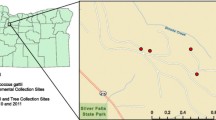Abstract
Environmental isolations have established that Cryptococcus neoformans var. gattii serotype B appears to have a specific ecological association with Eucalyptus camaldulensis. The global distribution of the tree appears to correspond to the epidemiologic distribution of cryptococcosis caused by C. neoformans var. gattii. The epidemiology of cryptococcosis can primarily be explained by exposure to an infective aerosolized inoculum, such as basidiospores released from specific host plants and/or desiccated blastoconidia (yeast cells) disseminated from accumulations of dried pigeon dung. The ecology of C. neoformans still remains largely unresolved, studies on the host-parasite interaction between serotype B and E. camaldulensis are still in progress, and extensive environmental searches are now underway to determine the natural habitats of serotypes A, C and D.
Similar content being viewed by others
References
Ajello L. (1970): The Medical Mycological Iceberg. In: Pan American Health Organization, Proceedings (of the) International Symposium of the Mycoses, Washington, D.C. - pp.3–12 (PAHO Scientific Publication No. 205.)
BulmerG.S. (1990): Twenty-five years with Cryptococcus neoformans - Mycopathologia 109: 111–112.
ChippendaleG.M. (1988): Flora of Australia Volume 19 - Bureau of Flora and Fauna - Australian Government Publishing Service - Canberra.
ClancyM.N., FleischmannJ., HowardD.H., Kwon-ChungK.J. and ShimizuR.Y. (1990): Isolation of Cryptococcus neoformans gattii from a patient with AIDS in Southern California - J. Infect. Dis. 161: 809.
CohenJ. (1982): The pathogenesis of cryptococcosis -Journal of Infection 5: 109–116.
DimechW.J. (1991): Diagnosis, identification and epidemiology of Cryptococcus neoformans infection -Australian Journal of Medical Laboratory Science 12: 13–21.
EllisD.H. (1987): Cryptococcus neoformans var. gattii in Australia - J. Clin. Microbiol. 25: 430–431.
EllisD.H. and PfeifferT.J. (1990): Natural habitat of Cryptococcus neoformans var. gattii - J. Clin. Microbiol. 28: 430–431.
EllisD.H. and PfeifferT.J. (1990): Ecology, life cycle, and infectious propagule of Cryptococcus neoformans -The Lancet 366: 923–925.
IkedaR., ShinodaT., FukazawaY. and KaufmanL. (1982): Antigenic characterization of Cryptococcus neoformans serotypes and its application to serotyping of clinical isolates - J. Clin. Micro. 16(1): 22–29.
Kwon-ChungK.J., BennettJ.E. and RhodesJ.C. (1982): Taxonomic studies on Filobasidiella species and their anamorphs - Antonie van Leeuwenhoek J. Clin. Microbiol. 48: 25–38.
Kwon-ChungK.J., PolacheckI. and BennettJ.E. (1982): Improved diagnostic medium for separation of Cryptococcus neoformans var. neoformans (Serotypes A and D) and Cryptococcus neoformans var. gattii (Serotypes B and C) - Journal of Clinical Microbiology 15(3): 535–537.
Kwon-ChungK.J. and BennettJ.E. (1984): High prevalence of Cryptococcus neoformans var. gattii in tropical and subtropical regions - Zbl. Bakt. Hyg. A 257: 213–218.
Kwon-ChungK.J. and FellJ.W. (1984): Genus 2. Filobasidiella Kwon-Chung. in The yeasts a taxonomic study edited by N.J.W. Kreger-van Rij -Elselvier Science Publishers - Amsterdam.
Kwon-Chung K.J. and Yarma A. (1989): Cryptococcus neoformans - Ecology and epidemiology. In: 3rd Symposium Topics in Mycology - Mycoses in AIDS Patients - The Pasteur Institute p. 55–56.
Kwon-ChungK.J., Yarma, A. and HowardD.H. (1990): Ecology of Cryptococcus neoformans and prevalence of its two varieties in AIDS and non-AIDS associated Cryptococcosis. In: Mycoses in AIDS Patients, edited by H. Vanden Bossche et al., Plenum Press -New York.
Murphy J.W. (1989): Cryptococcosis. In: Immunology of the Fungal Diseases - edited by R.A. Cox - CRC Press - Inc.
PfeifferT.J. and EllisD.H. (1990): Environmental isolation of Cryptococcus neoformans var. gattii from California - J. Infect. Dis. 163: 929–930.
RipponJ.W. (1988): Medical Mycology: The pathogenic fungi and the pathogenic actinomycetes -3rd edition, W.B. Saunders Co. W.B. Saunders Co -Philadelphia.
RuizA., FromtlingR.A. and BulmerG.S. (1981): Distribution of Cryptococcus neoformans in a natural site - Infection and Immunity 31: 560–563.
21.SmithJ.M.B. (1989): Cryptococcosis (Chapter 3) in Opportunistic Mycoses of Man and Other Animals -C.A.B. International Mycological Institute - BPCC Wheaton Ltd. - Exeter.
StaibF. (1987): Cryptococcosis in AIDS -Mycological - diagnostic and epidemiological observations - Aids Forschung (AIFO) 2: 363–382.
Zacharin R.F. (1978): Emigrant eucalypts: gum trees as exotics - Melbourne University Press.
Author information
Authors and Affiliations
Rights and permissions
About this article
Cite this article
Ellis, D., Pfeiffer, T. The ecology of Cryptococcus neoformans . Eur J Epidemiol 8, 321–325 (1992). https://doi.org/10.1007/BF00158562
Issue Date:
DOI: https://doi.org/10.1007/BF00158562




